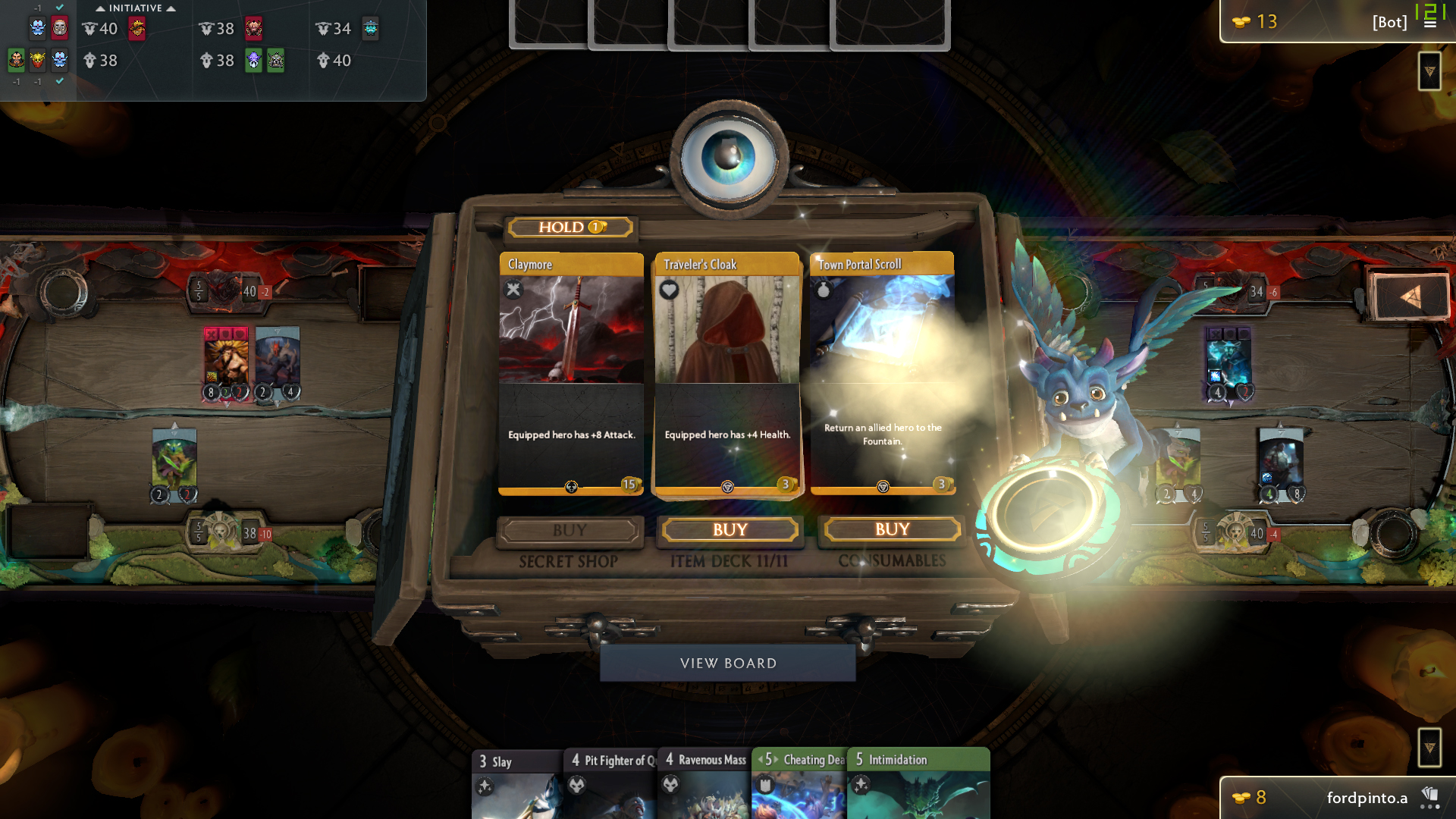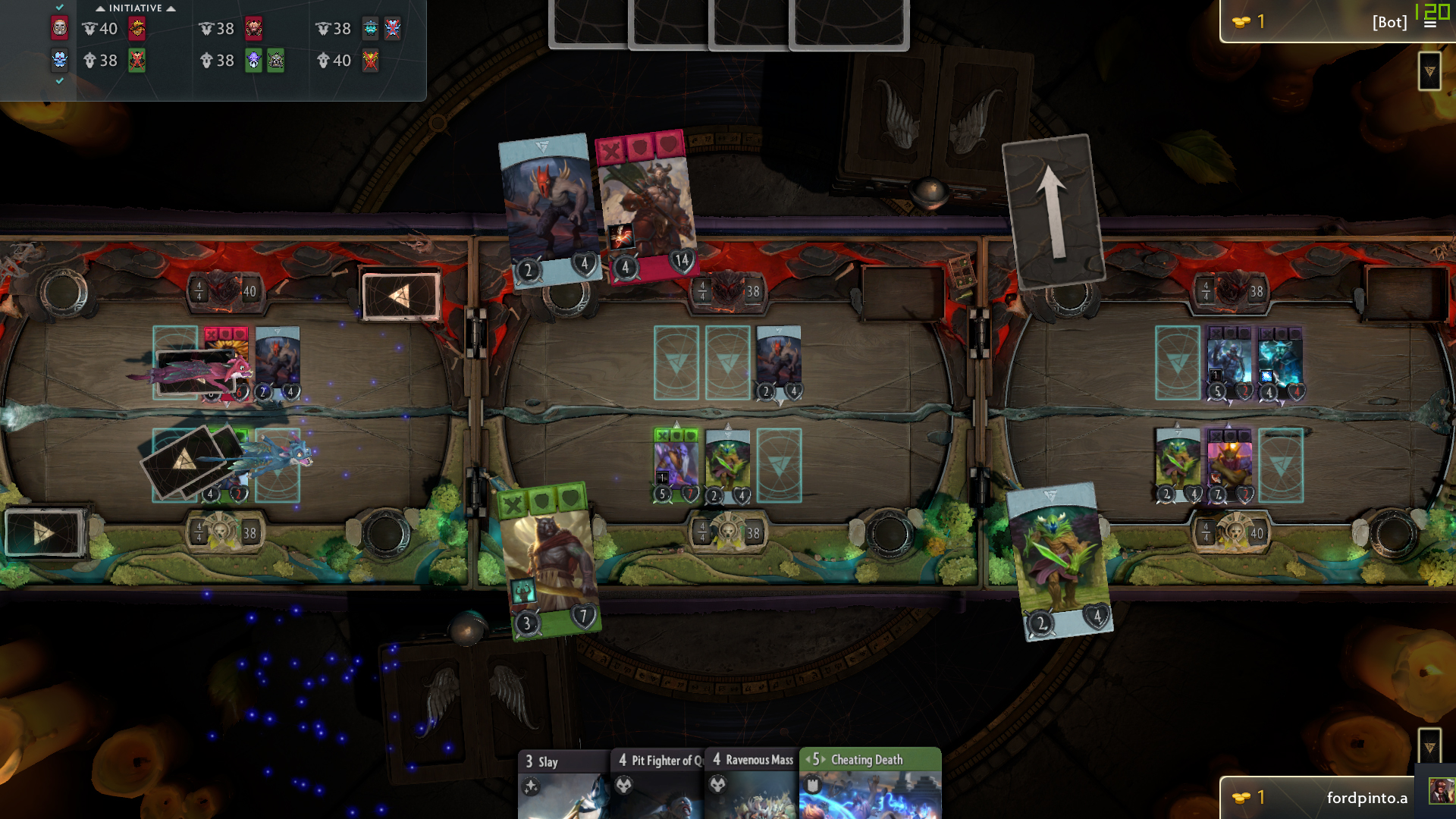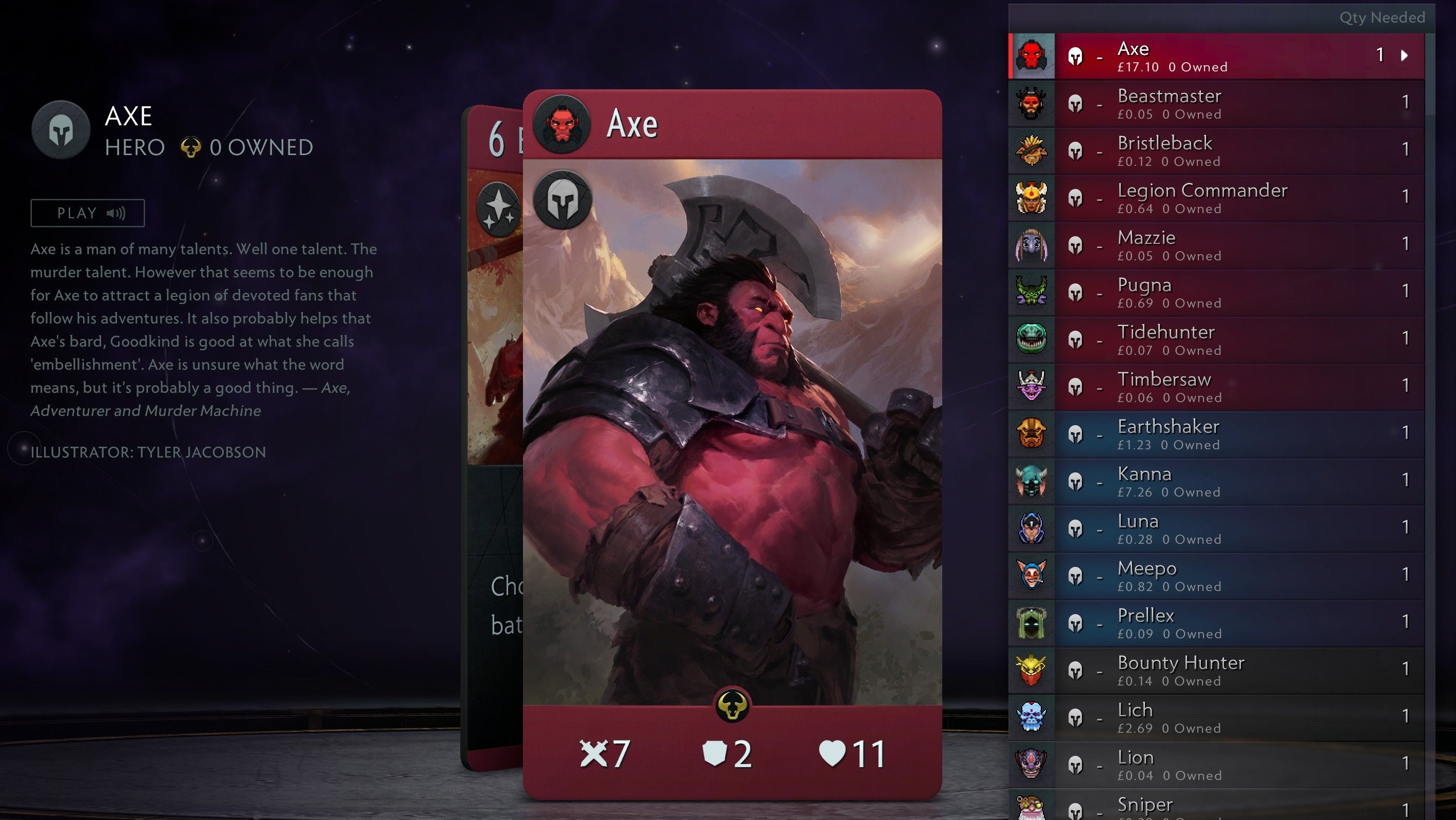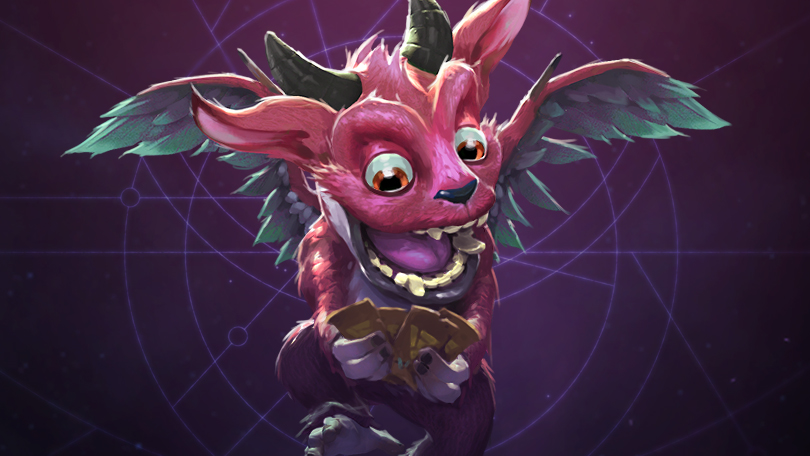Our Verdict
Building the best decks will cost you, but Artifact is an intricate and rewarding card game.
PC Gamer's got your back
What is it? A competitive card game themed after Dota 2.
Expect to pay $20, extra packs and cards cost extra
Developer/Publisher: Valve
Reviewed on: Intel i5-3570K, GTX 1060 6 GB Mini, 8GB RAM
Multiplayer: Yes, 1v1 in multiple modes
Link: Steam
It really sucks when all of your heroes die in Artifact. Granted, in my time with Valve's new card game, that hasn't happened too often. Maybe three times tops. A good thing for me, as there aren't many worse feelings in a card game than staring morosely at an unplayable Artifact hand while the enemy chows down on your exposed towers.
Heroes are the defining element of any Artifact match. You get five per deck, and three of them start on board, one in each of the three lanes. In the turns that follow, you get to to choose which lanes you want to deploy the remaining two in. Heroes come in four colours: red, green, blue and black. Crucially, these are the same four colours that make up the cards in your deck. Heroes determine what kind of cards you can play in a lane—if you want to play a red card, you need a red hero in that lane, and so on. Heroes assault your opponent's towers and protect yours, they swing lanes with their special abilities, and they bolster your deck with signature cards. You protect them and they protect you. When they die, you're usually sad.

Much like a game of Dota, winning in Artifact is all about making sure your heroes are in the right place at the right time. Regardless of their starting positions, which are chosen at random, heroes will shift from lane to lane over the course of the game. When a hero dies, it takes a turn on the bench before becoming available for redeployment in any lane. Artifact's main win condition is clearing your opponent's tower in two lanes, so usually you end up giving up one lane in a bid to maintain dominance of the other two. Of course, your opponent is trying to do the exact same thing, so every game is a constant push and pull as you try to outmaneuver one another and hold onto an advantage just long enough to push through lethal damage.
Unfortunately for me, I'd forgotten a crucial detail: her three heroes were about to respawn.
Extra complication, as if it were needed, is added by a secondary win condition: destroy the tower in one lane, and your opponent's Ancient will be exposed. Do 80 damage to that (basic towers only have 40 health, for comparison) and you win on the spot. This is an elegant design decision from Valve, as it rewards creative thinking from the player who's fallen behind.
In one memorable example, I was in a dominant position, on track to destroy the towers in two lanes while the majority of my opponent's heroes were out for the count. While I'd been focusing on my two winning lanes, however, my opponent had been quietly committing her resources to the first lane. There, she'd managed to clear my tower and begin her assault on my Ancient. I thought I was OK, though—I was set to deliver lethal on her other towers next turn, while she was only showing 30 damage in the lane were she was established. Unfortunately for me, I'd forgotten a crucial detail: her three heroes were about to respawn. As had clearly been her plan all along, she deployed them all in lane one and went ham on my defenceless Ancient, killing me before I had a chance to end the game myself.
I've snatched many such defeats from the jaws of victory during my time playing Artifact. What's surprising, though, is that the frustration never lasts too long. That's because I always leave feeling like there's something I could have done better. In that case, my mistake was overcommitting. A safer option would have been to deploy one hero in the first lane to stall—I would have still won in the other lanes, but slowed down my opponent just enough to keep my Ancient alive a turn longer. I lost, but knew better for next time.

Three and easy
Much has been made of Artifact's complexity—our own Tim Clark even likened it to "playing three games of Hearthstone at once". It's certainly true that a lot of the game's concepts will be new to even seasoned card game players. The three lane setup, which I've touched upon, certainly falls into this category. Artifact also has a Dota-inspired item system—every turn, there's a purchasing phase where players can spend gold earned from hero and creep kills on items to buff up their heroes. And then there's the 'initiative' mechanic, which sees players trade actions back-and-forth hot potato style, with the last player to act ceding their initiative to the opponent when play moves to the next lane.
All that said, I'm not sure Artifact's learning cure is as massive as some are making out. The tutorial, while on the brief side, does a good job of explaining the basics of how to play. I wasn't 100 percent on all of the nuances after I'd finished training, but I definitely knew enough to muddle through. It helps that Artifact's turn structure follows a predictable rhythm, with hero deployment, item-shopping at the end, and rounds of combat in each of the three lanes in between. I got the hang of things quite quickly.

Valve has done a great job crafting Artifact's visuals, too. Mischievous imps dart around the board, shipping the decks from lane to lane, wincing when your life total is low and guffawing when you apply the lethal blow. The interface is strong too. Information about cards is very easy to access: a quick double click will blow one up to full screen, where you can read the description more clearly, and mouse over any unknown keywords to quickly get their definition.
Is Artifact as visually appealing as Hearthstone? It's close, but my vote would still go to Blizzard's game. Artifact has a few impressive card effects, but none match the sheer variety of Hearthstone's. Valve have also opted not to take the ultra-interactive approach to game board design that Hearthstone favours—so there are no clickable objects to play with while you wait for your opponent to act. You get the feeling that Valve wanted the design to be front and centre. The interface screams 'serious card game' rather than 'fun card game to play on the can', which could be problematic for the eventual mobile version. There have definitely been times when I've felt a little far away from the action—especially when I zoom out to look at all three lanes at once.

Letting the draft in
Honing your deckbuilding skills is essential to mastering Artifact. And nowhere are those skills more critical than in draft, which is already being touted as Artifact's primary competitive mode. The basic structure is this: you select 60 cards from five 'packs' presented to you, whittle that pool down to a playable deck, then play until you either win five or lose two. Rewards, which come in the form of more entry tickets and card packs, are available depending on how well you do. There's also a casual draft mode, which allows you to practice with no entry fee—but you won't win anything if you do well.
Drafting in Artifact is a skillful business. The pros in the game's burgeoning competitive scene are trying to come up with sound logic on how best to pick, some even putting together tier lists that rank all the cards in each colour. However, there are so many judgement calls to be made in a draft—which colours to go heavily into, whether to pass up on a hero to wait for a better one, getting a healthy curve of mana costs in your deck, etc—that no resource is a substitute for experience. Already, we can see the best players putting together dominant runs in draft—former Hearthstone pro Lifecoach recently went 25 games without a loss.

Since every colour has different strengths and weaknesses, how you construct a deck depends very much on your own playstyle. I'm a degenerate aggro player, so I've found myself gravitating towards red and black—both colours that excel at establishing early dominance and rushing down your opponent's towers. Few things are more satisfying than buffing a packed board with Disciple of Nevermore, which functions something like Savage Roar in Hearthstone, and conjuring 20+ damage from nowhere. The beauty of the mode is that it allows you to identify the synergies between cards and colours, and then see them come to fruition. Every draft is different. I remember one time I made the last-minute call to integrate blue into my draft deck because the powerful hero Zeus appeared in a late pack, and the devastating effect of his hero-zapping signature card turned what would have been merely a good deck into an excellent one. The potential for creative thinking in draft is massive, and there's satisfying progress to be found in building up your knowledge one run at a time.
Costly constructed
After bolstering my collection from a few drafts, I shifted my focus to Artifact's constructed modes, where you build a deck with the cards you own. Much like draft, there's a casual mode for stakes-free fun, and an expert mode that offers rewards in exchange for an entry fee. My first attempt at deckbuilding was a red-green midrange build cobbled together from cards that had done well for me in draft. Not particularly confident, I opted to test it out in casual before putting my event tickets on the line. This turned out to be a good choice. Far from being the meta-breaker I'd hoped it would be, my deck was actually pretty terrible, and I got roundly destroyed in my first game.
My opponent's deck, however, was not terrible. It was amazing. As well as having both Axe and Drow Ranger, the two most sought-after heroes in the game, it also contained some of the most expensive rares. Now, it's not impossible I could have still found a way to win if I'd chosen the cards more carefully from my own deck, or even just played a little better, but it was still hard to escape the feeling that I'd lost because I'd spent less on card packs.
Artifact allows you to buy and sell your cards for real money via the Steam marketplace. This, theoretically, should allow players to get the cards they need without any massive outlay on packs. This system comes with upsides and downsides. One positive is that it's extremely easy to get hold of playsets of all the common cards, many of which are quite powerful. Strong uncommon cards tend to be a little more expensive, but for the most part their price is kept down by the sheer volume at which they are pulled from packs. Strong rares, however, can get really pricey. Axe and Drow Ranger, those two heroes that caused me so much distress earlier, currently cost $19.39 and $14.38 respectively.

This isn't to say spending money is mandatory if you want to enjoy Artifact's constructed mode. I ended up doing pretty well with a mono black deck made out of cards I had already, plus a few I picked up from the marketplace at a minor cost (with money I'd raised from selling my excess cards). Still, I doubt I'll be content with budget options forever. Coming from a card game background, I'm likely to just spend the money required to unlock the cards I need to be competitive. The only reason I haven't is that I haven't gotten bored of drafting yet, and I'd rather wait to see if I get the cards I need from my reward packs than buy them now and risk their value dropping. I'm aware, however, that I'm not necessarily the typical Artifact player. For some, that extra cost on top of a $20 purchase price is going to really sting.
Given the above, any conclusion I make about Artifact is going to come with some qualification. Value for money, I'm well aware, is going to be a big factor for many looking to buy the game. But the strength of the design will be enough to keep me hooked. Not only is Artifact's depth remarkable, it also doesn't come at any great loss of accessibility. I'm excited to see the metagame develop over the coming weeks and months. Let's just hope Axe's price comes down a bit.
Building the best decks will cost you, but Artifact is an intricate and rewarding card game.


